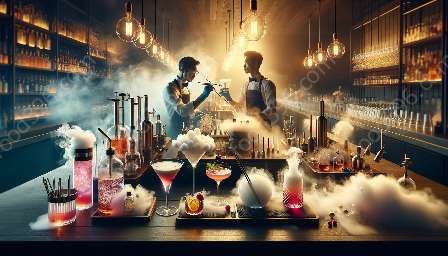Discover the fascinating world of liquid pearls and caviar in molecular mixology, where science meets art to create stunning drinks and culinary delights. In this comprehensive guide, we'll delve into the origins of liquid pearls and caviar, the techniques and tools used in molecular mixology, and provide innovative recipes to help you elevate your mixology game.
Understanding Liquid Pearls and Caviar
Liquid pearls and caviar are unique ingredients that have become integral to the world of molecular mixology. These tiny, flavorful spheres are created using the process of spherification, a technique popularized by molecular gastronomy pioneer Ferran Adrià. They are made from a variety of substances, including fruit juice, alcohol, and savory flavors, and encapsulate intense bursts of flavor.
The Science Behind Molecular Mixology
Molecular mixology is a cutting-edge approach to cocktail creation that applies scientific principles to the art of mixing drinks. It involves the use of modern tools and techniques, such as spherification, foams, and gels, to transform traditional cocktails into visually stunning and innovative creations. This approach allows mixologists to push the boundaries of flavor, texture, and presentation, resulting in unique drinking experiences.
Techniques in Molecular Mixology
When it comes to incorporating liquid pearls and caviar into molecular mixology, there are several key techniques that play a crucial role. Spherification, in particular, is a fundamental process for creating these miniature, flavorful spheres. By carefully combining sodium alginate and calcium chloride, mixologists can produce liquid pearls and caviar that add an element of surprise and delight to cocktails and dishes.
Methods for Creating Liquid Pearls and Caviar
There are different methods for producing liquid pearls and caviar, each offering unique benefits. Reverse spherification, for example, involves placing the liquid of choice in a bath of sodium alginate solution, while direct spherification requires dropping the liquid into a bath of calcium chloride. Both methods result in the formation of distinct pearls or caviar, each offering a burst of flavor when consumed.
Recipes and Applications
From sophisticated cocktails to imaginative culinary creations, liquid pearls and caviar offer endless possibilities for enhancing the overall sensory experience. Mixologists can experiment with flavors, colors, and textures to craft visually striking and palate-pleasing beverages that captivate guests. From molecular mixology cocktails featuring fruit-infused pearls to innovative garnishes for culinary dishes, the applications of liquid pearls and caviar are as diverse as the imagination of the mixologist.
Molecular Mixology and Liquid Pearls: A Match Made in Culinary Heaven
The marriage of molecular mixology and liquid pearls and caviar has transformed the way mixologists and chefs approach creativity in the realm of cocktails and cuisine. By infusing scientific techniques with artistic flair, mixologists and culinary professionals can elevate their craft and deliver unforgettable experiences for their patrons. What was once confined to laboratory experiments has now become a staple in modern mixology, offering a realm of infinite possibilities for those who dare to push the boundaries of conventional cocktail creation.
Conclusion
Liquid pearls and caviar represent a mesmerizing fusion of science and artistry in the world of molecular mixology. These innovative ingredients, coupled with modern techniques and tools, have paved the way for mixologists and chefs to captivate and delight their audiences with visually stunning and delectable creations. By embracing the principles of molecular mixology and experimenting with the versatile applications of liquid pearls and caviar, the possibilities for crafting distinctive and memorable drinks and dishes are truly endless.

